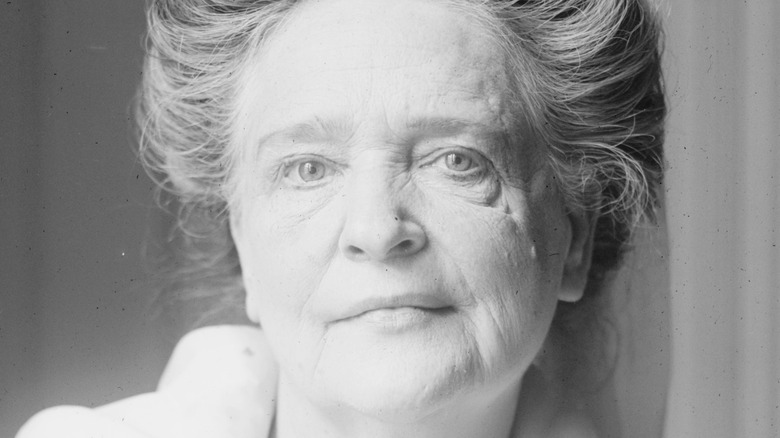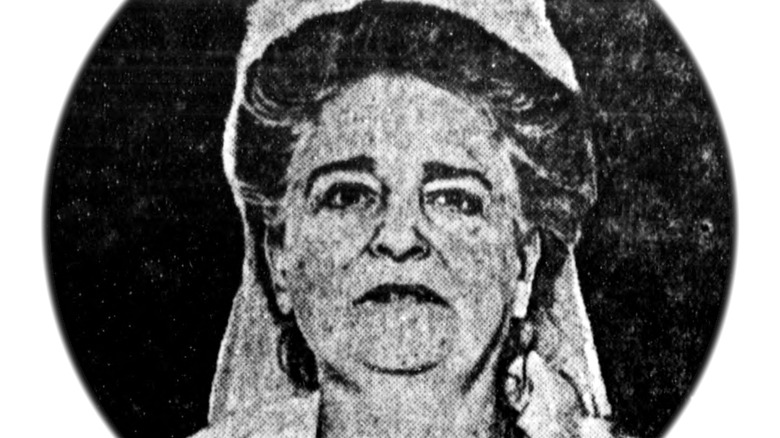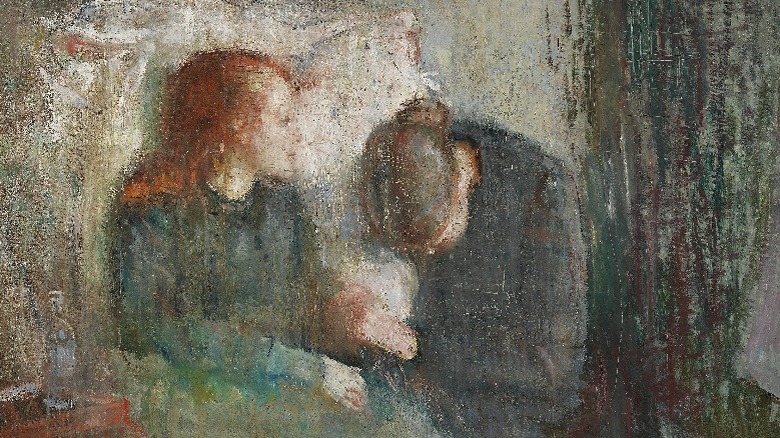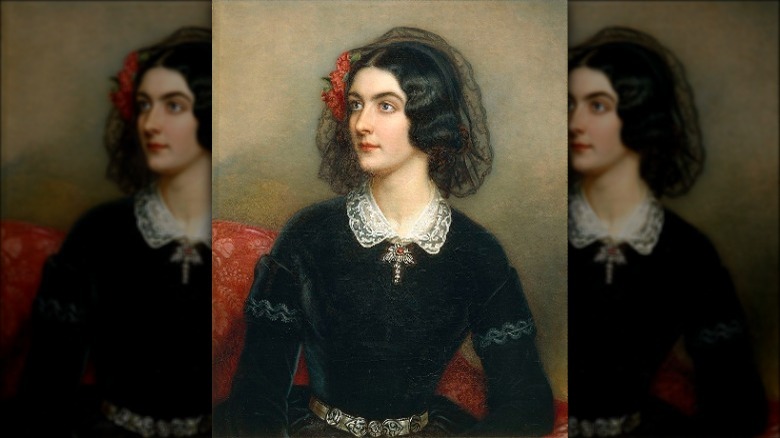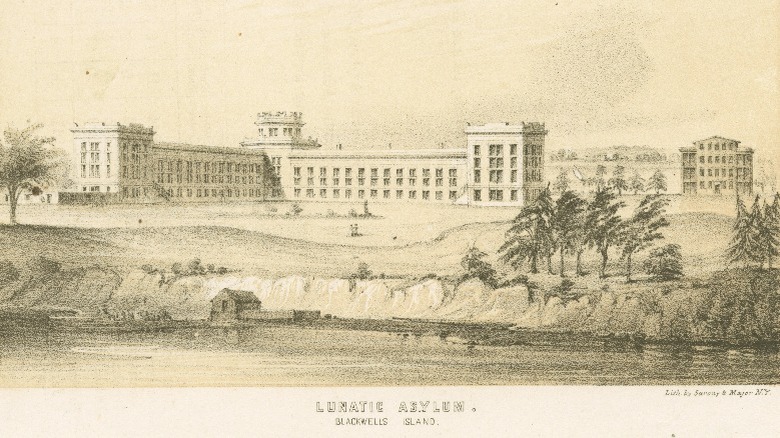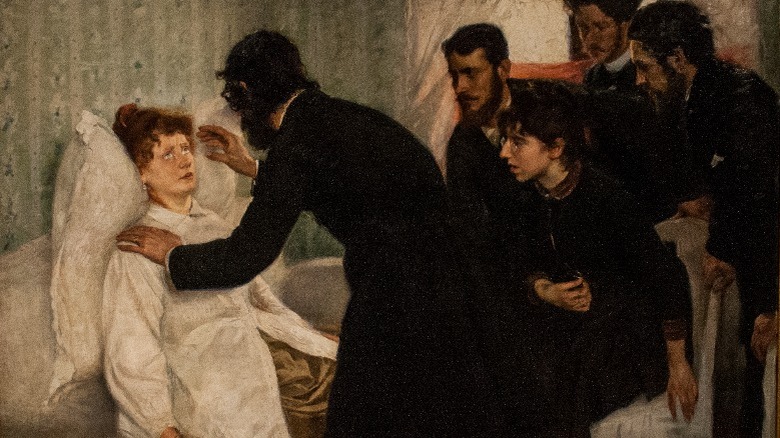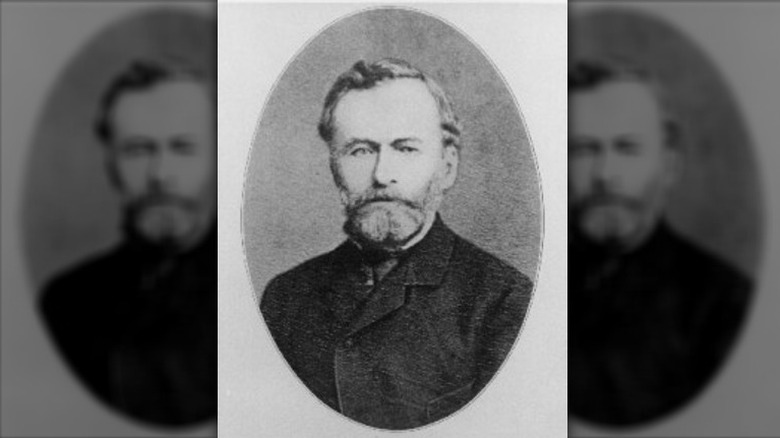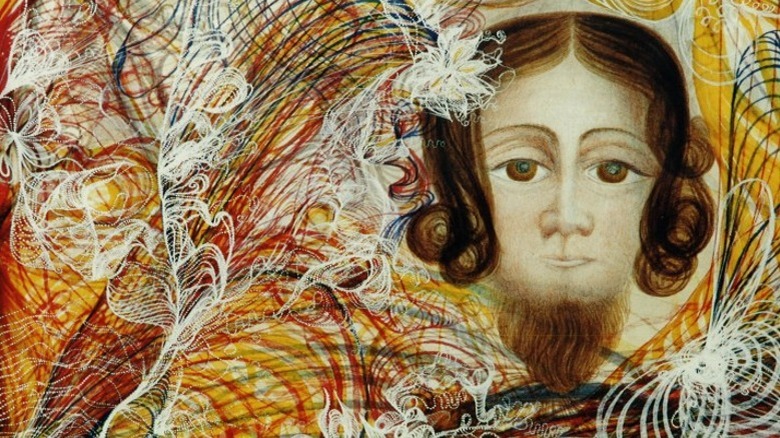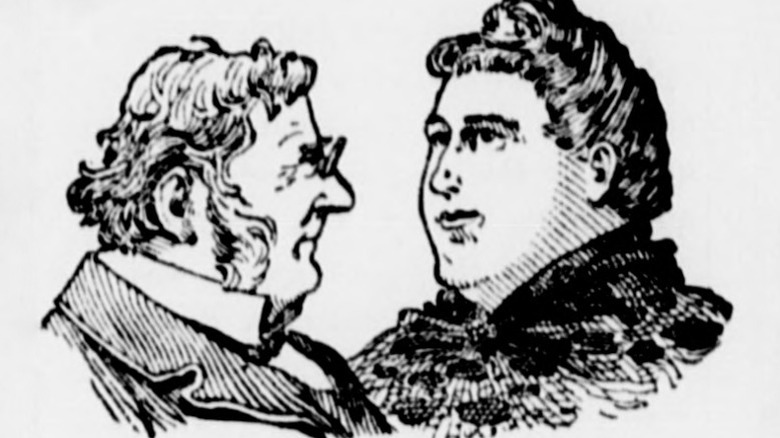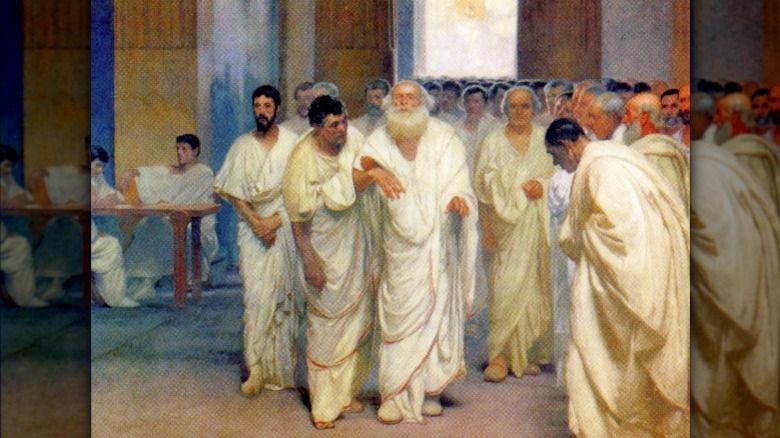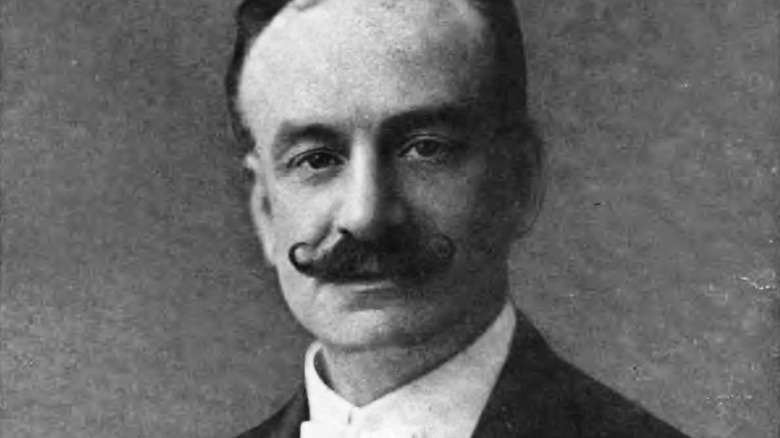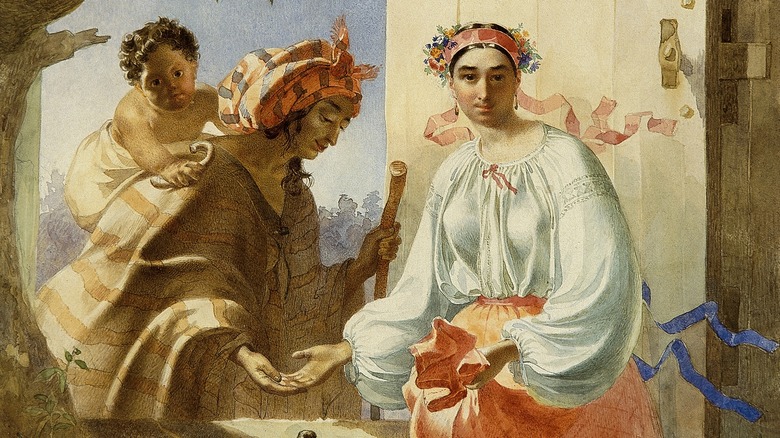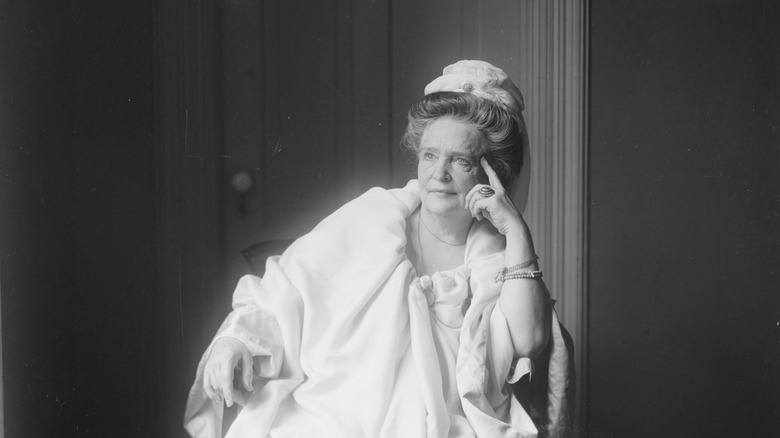Meet Ann O'Delia Diss Debar: The Fake Medium Even Harry Houdini Complimented
Harry Houdini is one of the best-known magicians and escape artists in history, but it is somewhat less well-known that he was — as Britannica explains — dedicated to using his knowledge of stage magic to expose charlatans and hoaxsters using magic tricks to con people into believing in the supernatural (and usually into giving them money). In fact, in 1924, he wrote a book on the topic called "A Magician Among the Spirits." In this book, he covers a number of notable charlatans, but there is one that he called "one of the most extraordinary fake mediums and mystery swindlers the world has ever known."
This swindler was Ann O'Delia Diss Debar, also known as Swami Viva Ananda, Sister Ignatius, "The White Lotus Mother," and a host of other names. But who was this dedicated con artist, and what kind of life did she lead that even Houdini had to begrudgingly admit to being impressed?
No one knows who she really was
The spiritualist and grifter known as Ann O'Delia Diss Debar was known by a suite of other names. The New York Times lists a few of the several dozen aliases she used in her lifetime, including Editha Lola Montez, Vera P. Ava, and Elinor L. Mason, but the one name that we don't know for sure is her legal birth name. While there is no concrete evidence of her birth records, most sources agree that she was born Edith Salomen (or Saloman or Salomon) in Kentucky in 1849. As the Feminist Studies Association explains, her father is believed to have been Professor John C.F. Salomen, who was a professor of music at the Greenville Female Institute in Harrodsburg, Kentucky, but her actual birth name might have been Ann O'Delia Salomen.
According to the book "Women Swindlers in America, 1860-1920" by Kerry Segrave, the young Editha Salomen would frequently run away from home, for increasingly long periods of time, always returning with a hard-to-believe story about some romantic escapade that had kept her away for so long. Historian Edmund Richardson records that when later in life Salomen found herself on trial, her own brother George spoke as a witness for the prosecution, saying of her, "She has cultivated nothing but bad principles and seems to thrive on them ... There is so much to be told about her that it passes human belief."
Beginning a life of crime
Historian Edmund Richardson says that the young Editha Salomen committed a streak of crimes and left a trail of debts all across the U.S. and beyond, quoting The New York Sun as saying, "Her campaigns have extended from the Atlantic to the Pacific, and from the lakes to the Gulf ... She skipped out of Kansas City leaving debts and a reputation as a beer guzzler." Even when she was caught, she could generally escape punishment by pretending to be dangerously ill. As the Chicago Tribune explains, she had an abscessed tooth from which she could suck blood, which skill she would use to fake tuberculosis.
On one such occasion, however, things didn't go so smoothly. While trying to ditch a hotel in Dayton, Ohio, without paying, she faked a particularly fatal-looking coughing fit that didn't convince the in-house doctor. When he threatened to use a hot iron to open her mouth and look inside, she body-checked the priest who had come to perform last rites as well as a handful of nuns and beat feet out of the hotel, just barely avoiding capture. This process of being caught faking and swindling led to Salomen being chased across the country by creditors, though she generally emerged unscathed, even if her escape required, as The New York Sun put it in 1888, "a general rumpus, a hair-pulling match, and the deuce [i.e., the devil] to pay generally."
Becoming a princess
At this point, Editha Salomen realized that this kind of heat and notoriety would make it difficult for her to continue the kind of scams she had been pulling. Once everyone knew Salomen was a con artist, who would rent her a room or lend her credit? In order to give herself a fresh start, she adopted the first of what would turn out to be literally dozens of false names and identities. According to "A Magician Among the Spirits" by Harry Houdini, this identity was that of Editha Lola Montez, the fictional daughter of King Ludwig I of Bavaria and his famous paramour, the dancer Lola Montez (pictured). Under this name, Salomen claimed to have been the lovechild of the famous couple who had been placed in a convent in Florence, which she had only recently left.
Posing as the child of a famous, scandalous pair, Salomen was able to make money by holding lecture series based on her own fictional life as the Countess Landsfeldt and Baroness Rosenthal, phony titles she bestowed on herself, before finally just calling herself a princess. However, her main source of money-making in this role was luring in gullible lovers and bilking them out of their money by asking for help with financial troubles that she always blamed on her incompetent bankers. Once she had all the money she could get out of one man, she would leave town to look for another fatuous fan of European nobility.
Stabbing her way out of prison
According to "A Magician Among the Spirits" by Harry Houdini, the success that Editha Salomen might have experienced with her princess con didn't make up for the fact that she wasn't actually a very good con artist, as she was constantly getting caught. Even though she had managed to pull her love trap on any number of young men in Baltimore, her act wasn't super convincing to people who really knew anything about European nobility. Nevertheless, she managed to cheat various gullible boys out of about a quarter of a million dollars in 1870 money, which is presumably about a quadrillion in modern funds. She fell into a life of luxury and got into smoking opium-laced cigarettes, which landed her in the hospital with a bout of "nervous exhaustion." Illness, whether genuine or faked, had once again kept Solomen out of jail.
She ended up in a psychiatric hospital on Blackwell's Island in New York, according to "Some Human Oddities: Studies in the Queer, the Uncanny, and the Fanatical" by Eric John Dingwall. where she really amped things up by trying to stab her doctor and escape. In the fray, however, she ended up stabbing not her doctor, but rather a nearby medical student named Paul Noel Messant. Rather than being subsequently sent to, like, double jail, Salomen was declared insane and sent to an asylum. The diagnosis of insanity seemed to cover up a number of her recent crimes, including stabbing a guy. Time in the asylum merely gave Editha Salomen time to plan her next scams.
Marrying her victim and becoming a spiritualist
Since Editha Salomen was only faking mental illness, she only had to stop faking in order to receive a clean bill of health and a discharge from the asylum. According to The New York Times, Salomen's next move was perhaps her most unexpected of all: she got married. Well, that part isn't so surprising; she got married a bunch of times over the course of her life. What is surprising, though, is who she married. It was Paul Noel Messant. Yes, correct, as the Chicago Tribune explains, the man that she stabbed while trying to escape the psychiatric ward. Perhaps even more surprising, however, is that this marriage was (probably) not a scam. They had a daughter named Alice together, and the now-named Madame Messant seemingly left her life of crime behind her.
Until, that is, Paul Messant passed away in 1873. Now a widow, Madame Messant realized that grief was a powerful emotion that she could manipulate and use as a means for conning people. As Harry Houdini explains, it was at this time that Mme. Messant first ventured into the realm of the supernatural, as she began working as a professional hypnotist, at which she experienced some considerable success within her social circles. However, being the widow of a doctor didn't quite gain her access to the high-paying clientele she was really looking for, so she knew it was time to try a new identity.
Becoming Mrs. Diss Debar
At this point, Mme. Messant decided it was time not only for a new identity but also to up her game in the fake psychic racket. According to "A Magician Among the Spirits" by Harry Houdini, she managed to kill two birds with one stone by marrying General Joseph Hubert Diss Debar, an artist of French origin and minor government official in West Virginia. (As historian Edmund Richardson points out, however, Joseph, a naturalized citizen and skilled artist who designed the West Virginia state seal, was by no means actually a general.) The general fell for Mme. Messant, leaving his wife and children for her, and the former Princess Editha gained the name by which her crimes would be best known, Ann O'Delia Diss Debar. The two of them lived in New York, where Ann decided to put all her effort behind her spiritualism.
As the wife of someone people believed was a general, Ann found herself living comfortably amongst high society, a group of people for whom hypnotism and mediumship were in great fashion. She made a great deal of money this way, but due to her spendthrift nature, she found herself in dire financial straits once again, but now people were growing bored of hypnotism, so she shifted to mediumship, and she was able to make a great deal of money by doing cold readings on those who had lost loved ones to feign communication with their spirits.
A specialist in spirit painting
Cold reading is perhaps one of the most common tactics for charlatan psychics, so that alone wouldn't be enough for Ann O'Delia Diss Debar to stand out in a field of phony spiritualists. Instead, what she was and is most famous for is her skill for "spirit paintings." Per Atlas Obscura, Diss Debar had a reputation for not only being able to communicate spoken messages from the dead, but she could allegedly also produce visual images and paintings from them as well. The guests at these seances would be seated with blank canvases, and during the ceremony, these canvases would suddenly, seemingly supernaturally, be filled with images from beyond the grave. At first, Diss Debar simply claimed these paintings – or "spook pictures" as they were called in newspapers – were produced by the loved ones of the bereaved guests, but soon she was claiming to be able to summon new artworks by the great masters of history, such as Michelangelo.
People who examined the wealth of new paintings produced at these seances soon began to notice that the paintings were actually bad, as if an unskilled hand had copied them from a more experienced artist. It seems Diss Debar was copying the old masters on specially prepared canvases treated with photo development chemicals that she could use to make images "magically" appear with a single touch of a wet sponge.
Hooking a big fish
Ann O'Delia Diss Debar's fraudulent spirit paintings became such a sensation that she managed to land an exceptionally wealthy and exceptionally gullible target in the form of Luther Marsh, one of the richest and most respected lawyers in New York. As Harry Houdini himself said in his book "A Magician Among the Spirits," Marsh's brilliance in the field of law did not keep him from being, in Houdini's own words, "an exceedingly easy mark." Marsh had recently lost both his wife and young daughter and was desperate to communicate with them on the other side. This fragile emotional state made him particularly vulnerable to Diss Debar's wiles.
According to historian Edmund Richardson, Diss Debar would conjure up comforting messages from Marsh's wife and daughter, and soon used her spirit painting technique to produce drawings and other images from not only Marsh's loved ones but also from famous artists like Rembrandt. As Marsh's house filled up with these counterfeit paintings, his gratitude grew to the point that he just straight up gave Diss Debar his house, which she turned into a Spiritualist "Temple of Truth." The ghost of Marsh's daughter had told him he should, you see. However, Marsh was so impressed by Diss Debar, that he planned a public exhibition of her powers without her knowledge. Put on the spot with no time to prepare, Diss Debar found herself unable to replicate many of the spectral wonders she had become so famous for.
Luther Marsh's ancient ghost friends
Luther Marsh's daughter and wife were not the only figures who communicated with him from beyond the veil through Ann O'Delia Diss Debar's mediumship. As historian Edmund Richardson explains, Marsh was an ardent enthusiast of the Classical world, and this was something that Diss Debar took full advantage of. Diss Debar claimed to have summoned the spirit of Apelles, the court painter of Alexander the Great, to do a number of her spirit paintings, including medallions representing Plato, Socrates, Aristotle, Pythagoras, and Archimedes. She subsequently summoned the ghost of another painter, Polygnotus, to create supernatural portraits of Pelopidas, Epaminondas, Pericles, Homer, and Cicero. Likewise, via the medium, the ghost of the Roman statesman Appius Claudius Caecus, who commissioned the building of the Appian Way, the most famous of all Roman roads, informed Marsh that the lawyer was his direct descendant. Subsequently, a large portrait of Appius became Marsh's prized possession.
Paintings weren't even the end of it. Another spiritualist trick that Diss Debar pulled off was filling seemingly empty notebooks with dozens of pages of text written by a ghostly hand – in this case, allegedly new writing by such long-dead luminaries as Socrates and Aristotle. It was later revealed in court that this trick was accomplished by a simple sleight of hand trick: Diss Debar would just replace the blank notebook with a pre-filled one in the very act of wrapping the notebook up so that it would seem untouched.
The trial
Luther Marsh's friends and family soon became (understandably) worried about his mental state by the time he gave away his lavish townhouse to a woman who was so clearly a fraud. The other group of people angered and aghast at Ann O'Delia Diss Debar's claims was perhaps a less expected one: stage magicians. Practitioners of stage magic love to perform illusions, but generally resent anyone who scams people out of money by claiming magic is real. As such, as historian Edmund Richardson attests to, a number of prominent New York magicians began publicly replicating Diss Debar's spirit painting effects with simple chemical tricks and sleight of hand, proving how easily they could be done.
Between these displays and requests from Marsh's family, as well as character testimony from her own brother George, both Ann O'Delia Diss Debar and her husband were arrested for conspiracy to commit fraud. According to Harry Houdini, the trial was long and scandalous, with numerous professional magicians (including Carl Hertz, pictured) brought in to explain how Diss Debar did her tricks. During the trial, Diss Debar said she had been visited by the ghost of the Roman orator Cicero and a "council of ten," who very helpfully suggested she should return Mr. Marsh's property to him. In light of these mitigating circumstances, the Diss Debars' sentence was lessened such that the two spent only six months each in prison.
Giving cults a try
Obviously, such a high-profile trial would make it difficult for Ann O'Delia Diss Debar to operate as a con artist in New York again. Harry Houdini says she tried to make a living in the theater following her release from prison but met no great success. To that end, Diss Debar was never heard from in New York again. Though she might have liked her critics to think she was dead, instead she had simply gone to other cities, such as Chicago and Cincinnati, under the name Vera P. Ava, which turned out not to be enough to fool local police.
She traveled from city to city under a suite of new identities that people would, unfortunately for her, notice looked pretty much exactly like Ann O'Delia Diss Debar in a bad wig, after which she would speed off to a new city. During this period she traveled not only across the U.S. but also to London and South Africa, where she and a new husband, Frank Jackson, joined and founded a number of different cults under a number of different identities — none to any great success. This included one of their own invention, "The Order of the Crystal Sea," which Kerry Segrave explains in "Women Swindlers in America, 1860-1920" was nominally a mystic organization based around fortune telling, it was in fact a front for blackmailing their clientele. The Jacksons did a month of jail time for this, after which they were forced to leave town.
The disappearance of Mrs. Diss Debar
According to "A Magician Among the Spirits" by Harry Houdini, Ann O'Delia Diss Debar and Frank Jackson fled the U.S. at this point and tried new identities abroad, eventually making their way to London, where they landed in hot water for recruiting people into their new cult, "the Theocratic Unity," as The New York Times reported at the time. As Kerry Segrave explains in "Women Swindlers in America, 1860-1920," this new cult, led by "Swami Laura Horos" and her "son," Theo, was doing all right recruiting people until a member noticed that the Swami and her son-husband had stolen from her. For this, the couple were arrested and tried, and once the news hit international papers, people from the U.S. let the courts know just whom they had arrested. Over the course of the trial, it was revealed that a number of what one could generously call strange rituals were performed, which led to the couple being convicted on counts of theft, rape, and sodomy. They were each sentenced to seven years for these charges, the harshest sentence Diss Debar would ever receive.
In 1906, however, Diss Debar a.k.a. Laura Horos a.k.a. Laura Jackson would be set free on parole after less than five years. She immediately disappeared from London. Making her way back to the U.S., she tried some of her old schemes under new identities but now she was too well known, and no one wanted to give their money to a convicted sodomite. She was last heard from in 1909, and no one knows what happened to her after that.
